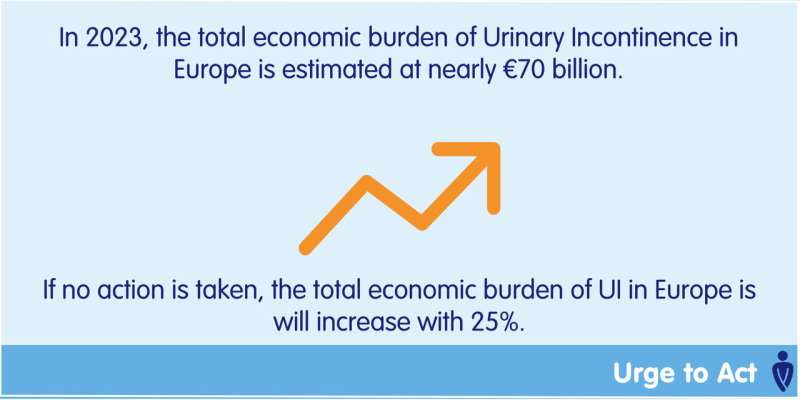This article has been reviewed according to Science X's editorial process and policies. Editors have highlighted the following attributes while ensuring the content's credibility:
fact-checked
trusted source
proofread
Annual economic burden of urinary incontinence could reach 87 billion euros in 2030 if no action is taken

New international research on the economic burden of urinary incontinence reveals that the cost of continence care will reach an estimated €69.1 billion in 2023. These costs include the impact of incontinence on individuals' health, the costs of medical consultations and products such as continence pads, incontinence-related absenteeism at work, nursing home admissions, and the environmental impact of incontinence care. If no action is taken to support continence health, the economic burden could rise by 25% in 2030, to €86.7 billion. This economic burden becomes considerably higher when including caregiver costs.
Some 55-60 million Europeans suffer from problems with continence health (the ability to control the bladder and bowel). However, the health, economic and environmental burden attributed to urinary incontinence (UI) is largely unknown. The European Association of Urology, together with 22 stakeholders, has initiated a campaign, Urge to Act, that aims to achieve substantial change in policies relating to incontinence across Europe. This campaign will be kicked off on 8 November in Brussels at the first European Continence Health Summit.
At the Summit, a socio-economic report, the first of its kind, presents the burden of UI in the European Union countries (EU) in terms of the prevalence, health care costs and the environmental impact from 2023 to 2030. The report demonstrates that across all EU countries, the estimated economic burden of UI was €69.1 billion in 2023. The economic burden for females was four times higher than males, and the economic burden increases by 16% when accounting for the informal support provided by caregivers. Concerning waste disposal of continence pads, the cost of incinerating (burning the pads) was marginally lower than recycling. However, the carbon footprint of recycling is significantly lower.
The economic analysis presented in this report estimates the economic burden of UI could increase by 25% if no action is taken, to €86.7 billion in 2030. Without better awareness, prevention, treatment and resource-wise use of continence technologies in cases when this often chronic condition cannot be cured, the economic burden will most likely increase.
To present solutions, the manifesto for policy reform on transforming EU Continence Health is launched in parallel. The manifesto, endorsed by 23 organizations, calls for concrete policy changes to face the challenges posed by the report and makes 10 high-level recommendations to European and national policymakers to recognize the importance of patient-centered continence care and to promote a holistic understanding of the intricate links between continence health and healthy aging, women's health, as well as disease areas like cancer, mental health, neurological problems and several other comorbidities such as obesity. This will require increased funding for continence health research.
Professor Philip Van Kerrebroeck, co-chairman of the Policy Office of the European Association of Urology and leading expert in the field of incontinence, says, "Continence problems are felt across gender, age, and socioeconomic backgrounds, and can result in a serious negative impact on individuals' quality of life. Physical, psychosocial and economic consequences for patients and their caregivers are a barrier to full participation in society. Optimal continence health should be a reality for everyone."
Since the risk of continence problems often correlates with conditions that develop or intensify as people age, it is predicted that these problems will increase, as the European population is aging at a rapid pace. Health professionals and informal caregivers are making every effort within the existing constraints of different health systems. However, current systems are not yet fully adapted to support continence care. Policies and laws in both EU Member States and non-member European countries tend to neglect continence care despite its prevalence, serious nature, and availability of solutions.
Van Kerrebroeckadds, "It is time to take action and transform this neglected issue to address the continence health challenge Europe is facing. In our Urge to Act campaign we would like to make policymakers aware that there are many ways to improve continence health, through increased prevention, better care, access to supportive interventions including treatment, and more inclusive environments. Much more should be done to reduce the direct expenses, the burden on patients, their caregivers, and on society."



















